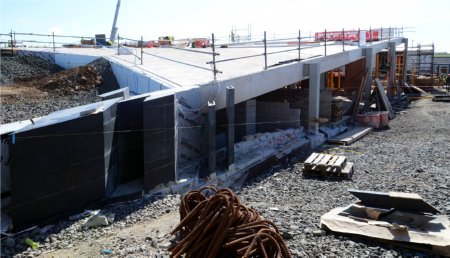 Work is progressing well on the National Trust’s £18m new visitors centre at the Giant’s Causeway, Northern Ireland. The new facility will include an exciting interpretive demonstration and state-of-the-art tourist information facilities.
Work is progressing well on the National Trust’s £18m new visitors centre at the Giant’s Causeway, Northern Ireland. The new facility will include an exciting interpretive demonstration and state-of-the-art tourist information facilities.
The European Regional Development Fund will provide £6.125m of the funding, the Northern Ireland Tourist will provide £3.125m, £3m will come from the Heritage Lottery Fund (HLF) and the remaining funding will come from fundraising. Gilbert-Ash are the main contractors and Heneghan Peng the architect.
The Giant’s Causeway is the most popular tourist attraction in Northern Ireland. Managed by the National Trust, it comprises an area of approximately 40,000 interlocking basalt columns which are the result of an ancient volcanic eruption. It is a protected site; therefore due to planning restrictions the building had to be built on the existing Brownfield footprint.
The new Giant’s Causeway Visitor Centre, which features a cafe and a shop, has been designed to complement the existing landscape. Graham Thompson, Project Director for the scheme, said: “Because of the delicate nature of the site, it was important to create a building that restored the integrity of the landscape. It is a highly innovative design, so for us to build such a sustainable building whilst adhering to planning restrictions – for instance we were not permitted any chimneys or aerials – was quite a challenge. To achieve the BREEAM ‘Excellent’ rating, we had to use recycled aggregates for the GGBS concrete. We also have two very innovative underground heating and cooling systems.”
He commented on the innovative use of local materials, saying: “We wanted to use Irish basalt. In order to make this possible, we had to identify a quarry and then work closely with a very high provision stone mason to get the stone from the quarry to the yard to the site. The grass roof to the building is also comprised of grasses that are indigenous to the area.”
The project has not been without its challenges. Because of the geometric nature of the design, combining the elements of the interior and the facade has proved incredibly difficult and has required intensive coordination. Furthermore, the design has a 1mm tolerance – virtually unheard of – and so each piece of stone has to be perfect. Lighting was also an issue as the 1800m² building is semi-buried. In order to make the building as light and bright as possible, impressive roof lights have been installed, which has also required excellent coordination between the contractors and the design team.
The stunning design for the one-storey Giant’s Causeway Visitors Centre is the result of an international architectural and landscaping competition, which Heneghan Peng won. Graham Thompson said: “When the building is completed, to most people it will be a bright, lovely building. The architecturally interested will see the amazing level of detail that has been put into this project. They will see the lines joining in the bright concrete, the precision and craftsmanship that has been involved in the stone, the intricate pathways, balustrades and the roof, and how it has all combined.”
The National Trust Acts enable the charity to declare land inalienable, which means that it must be conserved in perpetuity. Only places of the highest importance – such as Hadrian’s Wall – may be declared inalienable. Graham Thompson said: “We are doing something that is amazing and different: we are creating a building that we could declare inalienable because of its quality alone. Indeed, the quality of the building is so high that we would imagine that in two years time, it will be considered for the Stirling Prize. This truly is an incredible project to be involved with.”
The expected handover date is May 2012, and the centre will be open to the public in July.






